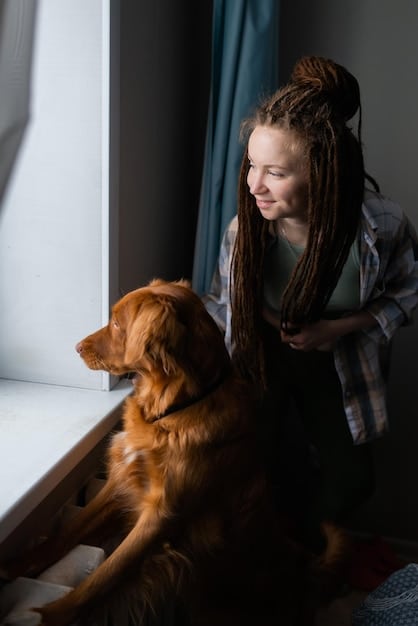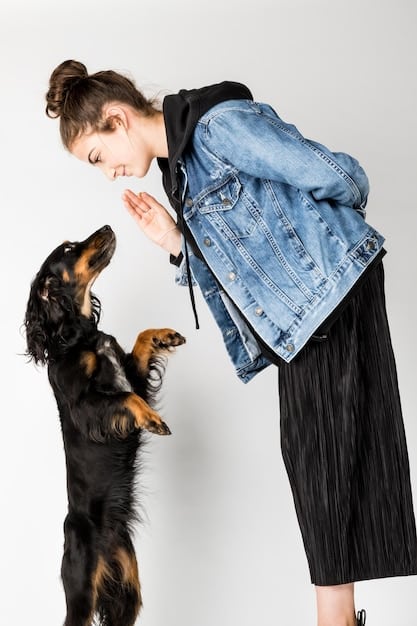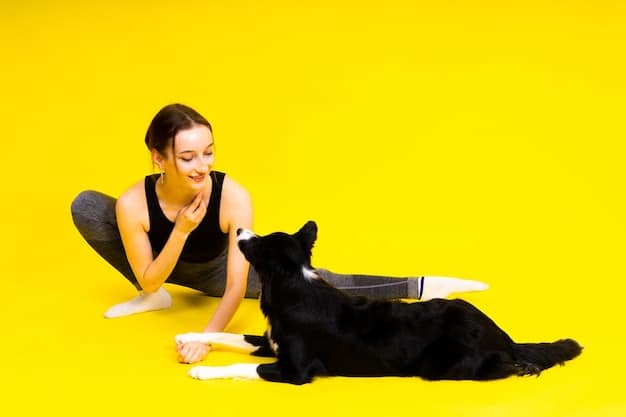Stop the Jump: Training Your Dog to Greet Without Leaping

Jumping on guests is a common behavioral issue in dogs, but with consistent training, using positive reinforcement techniques and managing the environment, you can teach your dog to greet people politely with all four paws on the ground.
Does your furry friend greet visitors with enthusiastic leaps? While it might seem cute, jumping on guests can be problematic. This comprehensive guide provides a training protocol to help your dog keep their paws on the ground, ensuring polite and safe greetings for everyone.
Why Dogs Jump and the Importance of Training
Jumping is a natural behavior for dogs, often stemming from excitement, attention-seeking, or even dominance displays. Understanding the reasons behind this behavior is the first step in effectively addressing it and implementing a consistent training protocol.
Why is it so important to curb this behavior? Beyond the immediate inconvenience, uncontrolled jumping can lead to several issues:
- Safety Concerns: A large dog jumping on a child or elderly person could cause injury.
- Damage to Clothing: Muddy paws can leave unwanted marks on clothing.
- Reinforcement of Undesirable Behavior: If jumping results in attention, the dog learns that it’s an effective strategy.
Therefore, establishing a training regimen that teaches your dog alternative, more acceptable behaviors is essential for both their well-being and the comfort of your guests. Early intervention can prevent the behavior from becoming deeply ingrained.

Setting the Stage: Management and Prevention
Before diving into training, it’s crucial to manage situations that trigger jumping. Prevention is often easier than correction, especially in the initial stages of training. This involves controlling the environment and minimizing opportunities for your dog to practice the unwanted behavior.
Effective management strategies include:
Using Physical Barriers
During guest arrivals, consider using a crate, leash, or baby gate to prevent your dog from immediately approaching and jumping. This provides a controlled environment where you can introduce your dog to guests in a more structured manner.
Leash Control
Keeping your dog on a leash during greetings allows you to maintain control and prevent jumping. Shortening the leash slightly can help discourage leaping while still allowing your dog to socialize.
Consistent management is key to preventing your dog from reverting back to jumping. By controlling the environment and limiting opportunities for unwanted behavior, you’re setting the stage for successful training.
The Core Training Protocol: Positive Reinforcement
The most effective method for training a dog not to jump involves positive reinforcement. This approach focuses on rewarding desired behaviors, making them more likely to occur in the future. It’s a far more humane and reliable approach than punishment, which can create fear and anxiety. Positive reinforcement builds a strong bond between you and your dog.
Here’s how to implement positive reinforcement effectively:
- Identify the Desired Behavior: The goal is for your dog to greet people with all four paws on the ground.
- Use High-Value Rewards: Tasty treats or enthusiastic praise will motivate your dog to perform the desired behavior.
- Be Consistent: Every time your dog refrains from jumping, reward them immediately. Consistency is key for clear communication.
Positive reinforcement requires patience and consistency, but the rewards are immense. Building a positive relationship with your dog through training fosters trust and cooperation.
Step-by-Step Training Techniques
Now, let’s delve into specific training techniques that you can use to teach your dog to greet people without jumping. These methods are based on positive reinforcement and aim to replace the jumping behavior with a more desirable alternative.
The “Sit” or “Stay” Command
Teaching your dog to sit or stay upon greeting is a reliable way to prevent jumping. Before a guest arrives, put your dog on a leash. As the guest approaches, command your dog to sit or stay. If they comply, reward them immediately with a treat and praise. If they attempt to jump, gently guide them back into a sitting position and repeat the command. Patience is vital.
The “Off” Command
If your dog jumps despite your efforts, use the “off” command in a calm and firm voice. As soon as all four paws are back on the ground, immediately reward them. The timing of the reward is crucial; it reinforces the specific action of having their paws on the ground.
Enlisting Guest Assistance
Ask your guests to participate in the training. Instruct them to only give attention to your dog when all four paws are on the ground. If the dog jumps, guests should turn away and ignore the dog until they settle down. This teaches the dog that jumping does not result in attention.
| Key Point | Brief Description |
|---|---|
| 🐾 Management | Use leashes and barriers to control greetings and avoid unwanted jumping. |
| 👍 Positive Reinforcement | Reward dogs for keeping paws on the ground with treats and praise. |
| 🗣️ Commands | Teach “sit” or “off” to redirect jumping into a calmer behavior. |
| 👨Guest Involvement | Have guests ignore jumping, rewarding calmness, consistently enforcing the behavior. |

Addressing Common Challenges
Even with a solid training plan, you may encounter some challenges along the way. Consistency, patience, and understanding are essential for overcoming these hurdles and achieving success.
Inconsistency from Others
If other members of your household or frequent visitors aren’t consistent with the training, it can confuse your dog and hinder progress. Communicate the training plan clearly to everyone involved. Explain the importance of only rewarding desired behaviors and ignoring jumping.
Overexcitement
Some dogs are naturally more excitable and find it challenging to control their impulses. For these dogs, consider incorporating calming exercises into their daily routine. These might include puzzle toys, chew toys, or a calming walk before guests arrive. Teaching relaxation techniques, such as the “settle” command, can also be helpful.
Regression
It’s not uncommon for dogs to regress in their training, especially during periods of stress or change. When this happens, revisit the basic steps of the training protocol. Manage the environment to minimize opportunities for jumping. Reinforce all the steps.
Advanced Techniques and Considerations
Once your dog has made significant progress with basic training, you can explore more advanced techniques and considerations to further refine their behavior. These strategies aim to generalize the learned behaviors to various environments and situations.
Varying the Environment
Once your dog is consistently greeting people politely at home, practice the same protocol in different environments, such as parks or friends’ houses. This helps your dog generalize the behavior, understanding that the rules apply regardless of the location. Start with low-distraction environments and gradually introduce more challenging ones.
The “Place” Command
Teaching your dog to go to a designated “place,” such as a dog bed or mat, upon hearing the doorbell can be a valuable tool for preventing jumping. Train your dog to associate the “place” with relaxation and positive reinforcement. When guests arrive, direct your dog to their “place” and reward them for staying there calmly. This creates a structured and predictable routine.
Conclusion
Successfully training your dog not to jump on guests requires a multifaceted approach that combines management, positive reinforcement, and consistent training. By understanding the reasons behind the behavior, setting clear expectations, and rewarding desired actions, you can transform your enthusiastic jumper into a polite greeter. Remember that patience and consistency are key, and the rewards of a well-behaved dog are well worth the effort.
Frequently Asked Questions
▼
Dogs jump for many reasons, including excitement, seeking attention, or as a display of dominance. Understanding the cause helps tailor the training approach.
▼
Use management techniques like leashes or barriers, teach alternative commands like “sit” or “off,” and reward calm behavior to reduce jumping.
▼
Positive reinforcement methods, like treats, praise, or toys, are effective for encouraging the desired behavior of keeping all four paws on the ground.
▼
Training time varies depending on the dog’s age, temperament, and consistency of training. It can range from a few weeks to several months.
▼
Prioritize prevention by using barriers or leashes. Train your dog to stay calm and offer reassurance to the person by keeping the dog at a distance.
Conclusion
By implementing the strategies outlined in this guide, you can effectively train your dog to greet guests politely without jumping. Consistency and patient work best.





